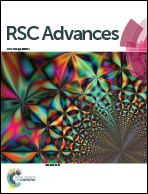Ultra-thin C3N4 nanosheets for rapid charge transfer in the core–shell heterojunction of α-sulfur@C3N4 for superior metal-free photocatalysis under visible light†
Abstract
The core–shell heterojunctions of ultra-thin C3N4 nanosheet enwrapping spherical α-S composites (α-S@C3N4) were fabricated via a self-assembly process by electrostatic force to realize enhanced photocatalytic ability under visible light. The photocatalytic ability can be adjusted by tuning the amount of the ultra-thin C3N4 nanosheet. The α-S@C3N4 composite with 35% composition of C3N4 nanosheet has the highest photocatalytic ability. The degradation rate of Rhodamine B (RhB) with α-S@C3N4 (35% C3N4) is 6.72 times faster compared to α-S as photocatalyst. This increase could be attributed to the efficient photogenerated holes and electrons separation by the heterojunction, which has excellent charge transfer ability arising from the ultra-thin C3N4 nanosheet. The stability of the α-S is also largely improved by the heterojunction construction.


 Please wait while we load your content...
Please wait while we load your content...